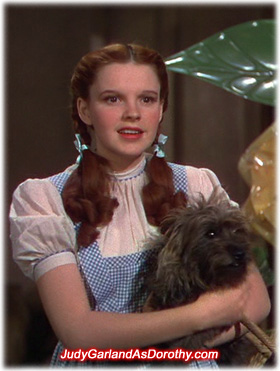| _____ |

|
The Wizard of Oz (1939) was directed by Victor Fleming is arguably one of the most well known movies of the century. The film was based on the book written in 1900 by L. Frank Baum titled The Wonderful Wizard of Oz. However, the film takes the book to another level, allowing the audience to receive an intimate visual experience, while creating a magical place in the Land of Oz that uses sound and color to go beyond one's imagination.
From 1922 to 1952, Technicolor was the filming process of choice in Hollywood and was characterized as hyper-realistic with saturated levels of color. Technicolor was used in The Wizard of Oz, and it's the first time we see Judy Garland feature in a full-length color movie. She appeared briefly with her sisters, singing in La Fiesta de Santa Barbara (1935), which was also color, but a short film. Even now, with advanced special effects and high definition quality in current Hollywood films, people still appreciate Dorothy's opening up of the door of her house in sepia tone and stepping into the Technicolor Land of Oz. Though initially The Wizard of Oz was not commercially successful, it achieved its status and fame through annual televised airings starting on November 3, 1956. Where else can one watch munchkins, wizards, witches and "lions, tigers and bears oh my?" The annual TV airing became one of the most anticipated events of the year as families would gather around the TV to watch Dorothy (Judy Garland), the Scarecrow (Ray Bolger), the Tin Man (Jack Haley), and the Cowardly Lion (Bert Lahr) travel through the mystical Oz and escape the Wicked Witch of the West (Margaret Hamilton) in order to return Dorothy to her home and find a brain, heart and courage respectively for the other characters. It became the perfect family film because the movie's explicit message is that even if it takes a journey to understand where you are and who you are, it may not be until the end of the road you will realize that "there's no place like home." The film emphasizes family as a core value. It has become such a household stable that whenever The Wizard of Oz is mentioned, people can instantly quote their favorite lines that they have memorized after watching the film again and again. However, beyond the messages at its surface, The Wizard of Oz attempts to become a political allegory for American society. The ideals used to establish its political messages, interestingly, have been relevant throughout our history and therefore is one main reason why this film has had timeless appeal. The 1930s and some of the 1940s has been labeled "The Golden Age of Hollywood" because during that time the classical Hollywood period dominated film production. The 1930s was the decade of experimentation with the sound and color revolutions. In addition, new genres were developed, new Hollywood stars were born and the studio system rose to elevated status. The Wizard of Oz is a classical Hollywood film that followed the narrative norms and conventions like that of other commercial cinema of its time. The Wizard of Oz was the movie that propelled Judy Garland into widespread fame and it was produced by one of the biggest production studios Metro-Goldwyn-Mayer (or MGM). The Wizard of Oz is not only one of the most well known films of the decade, but it is also ground-breaking in the history of mythmaking/fantasies and classical cinema. The most striking aspect of The Wizard of Oz is its advanced visual composition. At the time, color films were rare and expensive and The Wizard of Oz's use of Technicolor was a defining aspect in helping to transform and enhance the Land of Oz from ordinary to an extraordinary fantasyland. In addition, the sound composition helps propel the Land of Oz into an even more mystical place. |
_____ |

The Wizard of Oz darling, Judy Garland became the biggest child actress in the world, for her extraordinary performance as Dorothy.
